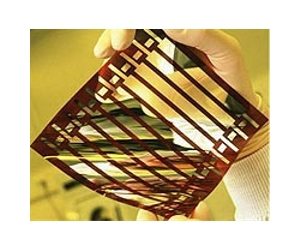Researchers from Iowa State University and the Ames Laboratory have developed a process capable of producing a thin and uniform light-absorbing layer on textured substrates that improves the efficiency of polymer solar cells by increasing light absorption.
"Our technology efficiently utilizes the light trapping scheme," said Sumit Chaudhary, an Iowa State assistant professor of electrical and computer engineering and an associate of the U.S. Department of Energy's Ames Laboratory. "And so solar cell efficiency improved by 20 percent."

Chaudhary said the key to improving the performance of solar cells made from flexible, lightweight and easy-to-manufacture polymers was to find a textured substrate pattern that allowed deposition of a light-absorbing layer that's uniformly thin - even as it goes up and down flat-topped ridges that are less than a millionth of a meter high.
The result is a polymer solar cell that captures more light within those ridges - including light that's reflected from one ridge to another, he said. The cell is also able to maintain the good electrical transport properties of a thin, uniform light-absorbing layer.
Tests indicated the research team's light-trapping cells increased power conversion efficiency by 20 percent over flat solar cells made from polymers, Chaudhary said. Tests also indicated that light captured at the red/near infrared band edge increased by 100 percent over flat cells.
Researchers working with Chaudhary on the solar cell project are Kai-Ming Ho, an Iowa State Distinguished Professor of Physics and Astronomy and an Ames Laboratory faculty scientist; Joong-Mok Park, an assistant scientist with the Ames Laboratory; and Kanwar Singh Nalwa, a graduate student in electrical and computer engineering and a student associate of the Ames Laboratory. The research was supported by the Iowa Power Fund, the Ames Laboratory and the Department of Energy's Office of Basic Energy Sciences.
The idea of boosting the performance of polymer solar cells by using a textured substrate is not a new one, Chaudhary said. The technology is commonly used in traditional, silicon-based solar cells.
But previous attempts to use textured substrates in polymer solar cells have failed because they require extra processing steps or technically challenging coating technologies. Some attempts produced a light-absorbing layer with air gaps or a too-thin layer over the ridges or a too-thick layer over the valleys. The result was a loss of charges and short circuiting at the valleys and ridges, resulting in poor solar cell performance.
But, get the substrate texture and the solution-based coating just right, "and we're getting more power out," Nalwa said.
The Iowa State University Research Foundation Inc. has filed a patent for the substrate and coating technology and is working to license the technology to solar cell manufacturers.
"This may be an old idea we're using," Chaudhary said, "but it's never before been successfully implemented in polymer solar cells."